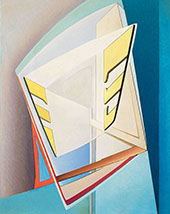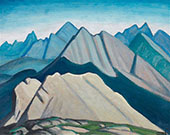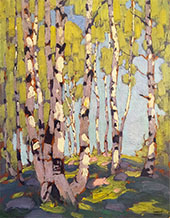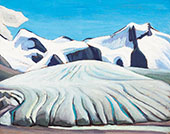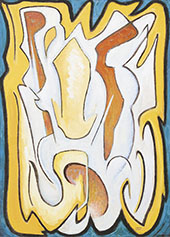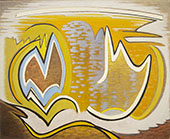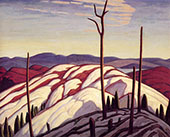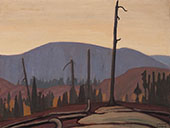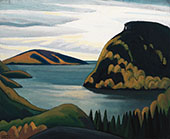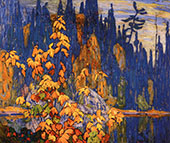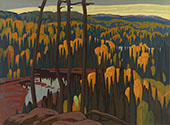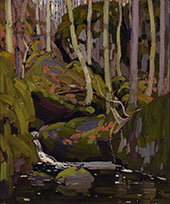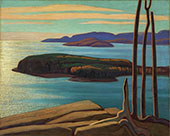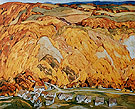Group of Seven Oil Painting Reproductions
Find Group of Seven Oil Paintings Replicas by Group of Seven Artists
Group of Seven Painting: A Brief Introduction
Group of Seven was an association of Canadian artists working during the early 20th century. They are sometimes known as the Algonquin School, whose oil paintings focus on Canadian landscapes and direct contact with nature. These artists strongly believed in a distinct style of Canadian art, reflecting the nation’s unique identity and environment. As a result, their art often features large planes of bright color and a flat painterly perspective.
This brief introduction presents some Group of Seven famous oil paintings alongside the leading artists of this art movement.
Who were the Seven Members?
The Group consisted of seven artists who came together between 1920 and 1933.
● Franklin Carmichael
● Lawren Harris
● A. Y. Jackson
● Frank Johnston
● Arthur Lismer
● J. E. H. MacDonald
● Frederick Varley
Three artists were later invited to join the Group of Seven. These are A J Casson, who joined in 1926, Edwin Holgate, joining in 1930; and Lionel LeMoine FitzGerald, who became a member in 1932. In addition to these formal members, paintings by Tom Thomson and Emily Carr also link with the art movement. Although Tom Thomson died before the group's official formation, his paintings represent the look and feel of the group. Indeed, describing Thomson’s role, Lawren Harris said he was part of the movement “before we pinned a label on it.”
The group disbanded in 1933, succeeded by the Canadian Group of Painters, and included many artists from the “Beaver Hall Group” who often exhibited alongside the Group of 7. There was a substantial crossover in membership between the two groups. Franklin Carmichael, Emily Carr, A J Casson, and Lawren Harris were all founding members of the Canadian Group of Painters. Lawren Harris, LeMoine FitzGerald, A. Y. Jackson, and Arthur Lismer also played a part.
Why were these Canadian Landscape painters controversial?
The Group of Seven launched their first exhibition in 1920 to a mixed critical reception. Indeed, one review compared their paintings to the insides of a “drunkard’s stomach.” However, As the decade progressed, many recognized these artists as pioneering a new and distinctly Canadian art form. Many Canadians defended the Group painters in response to the negative reviews, acknowledging their importance in the nation’s identity and self-expression.
Paintings by the Group 7 were controversial for their “terra nullius” approach to the Canadian landscape. This phrase refers to the idea that Canadian land was entirely untouched and pristine before white settlement. However, this conception completely erased indigenous peoples from Canadian history. Additionally, many contemporary Canadians found the group’s romantic, almost mystical approach to art shocking. People were more used to Classical and mythological subjects, and the Group of Seven’s radical approach split public opinion. Their self-identification as Canada’s “first national school of painters” also drew ire from the traditional art establishment.
Despite these controversies, present-day art historians celebrate the Group's paintings for their rugged, wind-swept panoramas. Group of 7 art represents a romanticized notion of Canadian strength and national independence. As well as expressing political and social undertones, the Group’s paintings used vivid coloring and expressive handling of paint with simple yet energetic compositions.
What inspired the Group of 7 Artists?
Even with their self-identification as a national school of Canadian artists, the Group of Seven drew inspiration from French Post-Impressionism. This inspiration includes artists such as Vincent van Gogh and Paul Gauguin. Other European trends, noticeably the Symbolism of Edvard Munch, were also influential. Against this inspirational backdrop, the Group rebelled against prevailing naturalist trends in Canadian art. As the predominant nineteenth-century style, it focused on highly finished realistic paintings. Instead, these artists pursued a more direct relationship with nature, prioritizing emotional responses to the landscape; this way, the group moved away from mere imitation of nature.
Their expressive, emotive approach appears in a series of paintings on Lake Superior by Lawren Harris. In oil paintings created throughout the 1920s, Harris presents varying views of the lake, each with emotional resonance and impact.
Famous Paintings by the Group of Seven
The Jack Pine by Tom Thomson is one of the most famous paintings associated with the Group. In this oil painting, Thomson imbues the lone Jack Pine, an iconic Canadian tree with almost human, sentinel-like qualities. Gentle pastel skies contrast with the dark silhouetted forms of the tree and looming mountains in the distance.
Famed for his depictions of Ontario’s landscapes, Thomson dedicated his life to preserving the Canadian wilderness. He worked as a guide and ranger in Algonquin Park but sadly drowned in mysterious circumstances. Thompson disappeared on a canoeing trip on Canoe Lake and was later found with suspicious wounds to his head. Intriguingly, Thomson painted Canoe Lake on multiple occasions. Lightning Canoe Lake and Evening Canoe Lake are two of his most atmospheric oil paintings on canvas.
Where is The Group of Seven paintings?
The National Gallery of Canada in Ottawa boasts one of the largest Group of Seven collections. Indeed, they hold over 2,500 Tom Thomson paintings alongside works from the movement’s other leading artists. Under the direction of Eric Brown, the National Gallery of Canada was an early supporter of the Group, and the Museum bought many oil paintings on canvas from their early exhibitions.
The Art Gallery of Ontario in Toronto and the McMichael Canadian Art Collection in Kleinberg, Ontario, display several Group of 7 artworks. Paintings by A J Casson appear in the McMichael collection, including the artist's iconic and famous painting White Pine 1957. Then known as the Art Gallery of Toronto was also the site of the first Group of Seven exhibitions held in 1920.
Group of 7: Replica Oil Paintings for Sale
Explore our extensive replica art collection for many Canadian landscape paintings. Buy high-quality art reproductions from leading Canadian artists as offered in our Landscape Paintings collection.
Enjoy discovering colorful wall art of the Canadian landscape in your home or office. From the paintings of Tom Thomson to A J Casson's artworks, our famous painting reproductions are available to suit everyone.
Cannot Find What You Are Looking For?
Reproduction Gallery Information
Customer Service
(Send Us A Message)
Tel: (503) 937 2010
Fax: (503) 937 2011



